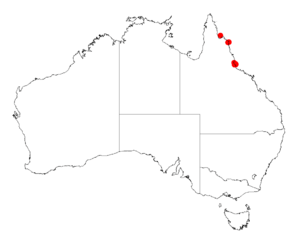Hitchinbrook wattle facts for kids
Quick facts for kids Hitchinbrook wattle |
|
|---|---|
| Scientific classification | |
| Genus: |
Acacia
|
| Species: |
homaloclada
|
 |
|
| Occurrence data from AVH | |
The Hitchinbrook wattle, also known as Acacia homaloclada, is a type of shrub. It belongs to the Acacia family, which is a large group of plants. This special wattle only grows in one specific area: north-eastern Australia. When a plant or animal is found only in one place, it's called endemic.
Sadly, the Hitchinbrook wattle is considered a vulnerable plant. This means it's at risk of disappearing if we don't protect it. It's listed as vulnerable under a law called the 1992 Nature Conservation Act.
Contents
What Does the Hitchinbrook Wattle Look Like?
This shrub can grow quite tall, up to about 5 meters (which is like a small tree!). It has a somewhat thin and spread-out shape. Its branches are flat towards the ends, and when new shoots grow, they are a pretty pink color.
Like many Acacia plants, the Hitchinbrook wattle doesn't have regular leaves. Instead, it has what are called phyllodes. These are flattened leaf stems that look and act like leaves. The phyllodes of this wattle are thin and stay green all year round.
They are shaped like a spear or a narrow oval, usually 6 to 12 centimeters long and 9 to 20 millimeters wide. Each phyllode has three clear lines (nerves) running along its length. The Hitchinbrook wattle blooms in late spring and early summer, typically between November and December, showing off bright yellow flowers.
Naming and History of the Hitchinbrook Wattle
The scientific name for plants and animals is very important. It helps scientists around the world know exactly which species they are talking about. The Hitchinbrook wattle was first officially described by a botanist named Ferdinand von Mueller in 1878. He wrote about it in his work called Fragmenta Phytographiae Australiae.
Over time, scientists sometimes change how plants are classified. For a while, in 1987, this wattle was put into a different group called Racosperma homalocladum by Leslie Pedley. But later, in 2001, it was moved back to the Acacia group, where it is known today as Acacia homaloclada.
Where the Hitchinbrook Wattle Grows
The Hitchinbrook wattle has a very small natural home. It is found only in northern Queensland, a state in Australia. You can find it near the town of Ingham, and also on Hinchinbrook Island. It's not a very common plant, even in these areas.
This wattle usually grows near rivers or streams. It likes to be part of open Eucalypt forests, which are woodlands filled with gum trees. It prefers to grow in sandy soils.
Images for kids


